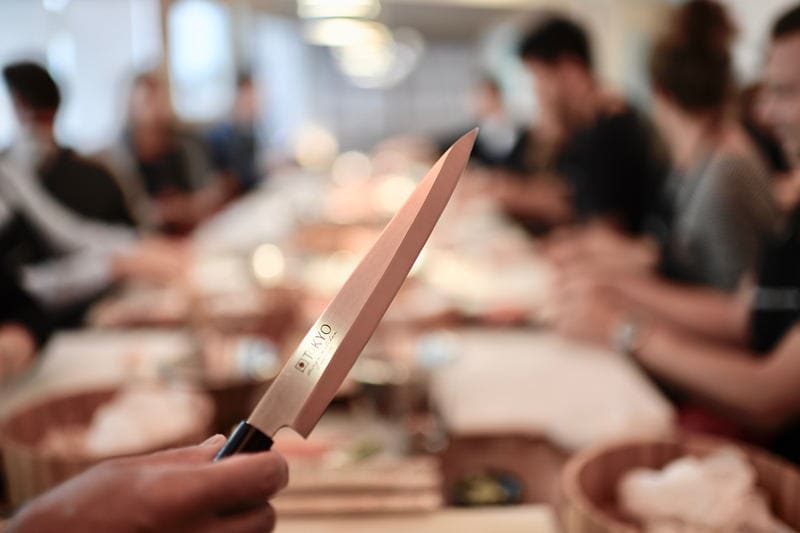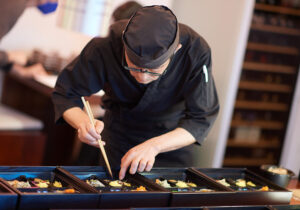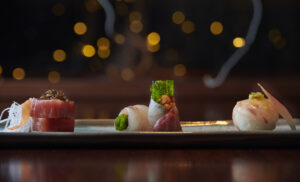In loose succession, we report in our SUSHIYA blog on the subject of Japanese knives and cutting techniques and thus accompany our Sushi course for advanced, which will be held for the first time in March 2018.
JAPANISCHE MESSER & SCHNEIDETECHNIKEN – EINE EINFÜHRUNG
In recent years, you can find more and more often offers of "Japanese knives". But what is the fascination of real Japanese knives? Is a Damascus knife always a Japanese and at the same time particularly sharp knife?
Let's start with the last question: no, because the impressive pattern of a knife with Damascus steel is created by numerous folds during forging and is therefore costly to produce (and not entirely cheap), but it initially says nothing about the sharpness of a knife. The decisive factor for the sharpness of a knife is the steel of the blade or, more precisely, the cutting edge. Only if it is made of the somewhat more brittle "blue" steel can it be sharpened to the extraordinary sharpness for which Japanese knives are famous.
What is actually so special about genuine Japanese knives? Why are they so popular with amateur and professional chefs all over the world?
IDENTIFYING FEATURES OF GENUINE JAPANESE KNIVES
There are some characteristics by which you can tell if it is a "real" Japanese knife or an adaptation (for foreign countries):
- Stainless knives are made of special steel that cannot be ground as finely as traditional knives, which are forged from two types of steel ("white" and "blue"). Knowing and hitting the ideal blend of hard and soft is a true art in this process. Such non-stainless knives require careful maintenance, for example, with camellia oil. A stainless knife can therefore not be a traditional Japanese knife.
- Japanese knives often seem huge, blade lengths of 30 cm or more are by no means exceptional. But why is this so? One reason is that, unlike in Western cuisine, a single pulling motion is used to complete the cutting process, so there is no "sawing back and forth" that leaves the cut surface of the product irregular and rough.
- Traditional Japanese knives do not have the finger guards of Western knives, which are designed to prevent you from hurting yourself while cutting. The blade is burned into the wooden handle, which is equipped with a ferrule (usually made of buffalo wood). The wood used is
- often honoki (gray magnolia), which is particularly hard and, accordingly, long-lasting and does not become so slippery when wet, but also
- Kokutan (Ebony黒壇) or
- Hinoki (Japanese cypress), which is said to have antibacterial properties, respectively.
- Japanese yew
- There are two types of blade cut: the V-shaped and the asymmetrical (half V), also known as the Kanto and Kansai cuts, respectively.
With their seemingly simple wooden handles, Japanese knives often appear visually less imposing at first than their more modern-looking Western counterparts. In fact, however, Japanese knives are often perfectly balanced hand tools that reflect the great depth and versatility of Japanese cuisine - and accordingly require more knowledge in use and care.
In the next episode, things start to get exciting: "Taste by cutting"...






